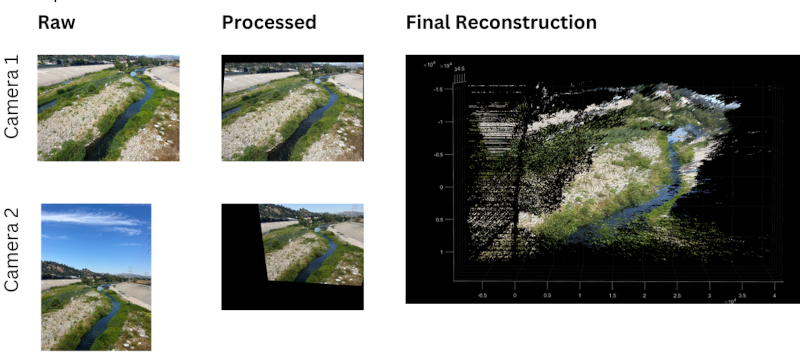[Lynnadeng]’s team wanted to monitor the Los Angeles River over time and wanted citizen scientists — or anyone, for that matter — to help. They built a dual phone holder to allow random passersby to use their phones to take photos. A QR code lets them easily send the pictures to the team. The 3D printed holder is fixed in place and has a known gap that allows stereo reconstruction from pairs of photos.
Of course, people aren’t going to know what to do, so you need a sign with instructions along with the QR code. One advantage to this scheme is that it’s cheap. All the camera hardware is in the public’s phone. Of course, you still have to make the holder robust to the elements, but that’s not nearly as difficult as supplying power and weatherproofing cameras and radios.
The real interesting part is the software. At first, we were disappointed that the post had a dead link to GitHub, but it was easy enough to find the correct one. In some cases, people will use a single camera, so 3D reconstruction isn’t always possible.
We love citizen science around here. No matter where you live, there are many opportunities to contribute.
















Two cell phones for stereo imaging? Really? One can find a two camera peripheral for Raspberry Pi with 8MP resolution on Amazon. This would be a cheaper, easier to build and easier to use. For example, with 2 phones how does on trigger both phones at the same instant? If the images of a moving object (flowing water) stereo viewing is not possible.
I think you’re missing that this solution doesn’t require them to buy any phones. Or other steal-able / breakable kit. It relies on members of the public using their own phones.
Hello….. One cell phone, 2 photos, one at a time on 2 separate holders to position the (same) phone, more or less in the same orientation. Software does the rest.
Heck, don’t most phones come with multiple camera sensors now? I know my HTC One M8 used to take “3D-ish” photos back in the day.
There are also apps that use camera in video mode to get better than stereo when you move the phone around. Most phones do full HD or better video resolution, so there is not that much loss to what is the actual resolution in photo mode either.
A 3D printed holder and a sign, how could you get cheaper? And besides this gives you thousands of photos over a long time period, for the same set up you’d need more than some Pi’s and cameras.
Step 6: Cut Brackets Out of Sheet Metal
Using the DXF file attached to this step, use a waterjet cutter to cut a rectangle from the steel sheet metal.
The key here, though, is that you are using the public’s phones. They are not dedicating two phones to the camera. Only the mount for you (and your friend) to put your phones and send them a picture.
Honestly, I think a significant part of the project is public engagement.
They’re trying to make the public think about water levels and river health. If they can get even a couple members of the public passionate about it, their funding and initiatives could gain a significant boost.
Perhaps you should tag this with “view master” and search HaD with that term.
I was disappointed that the processing software is not open source.
“Use an airgun to blow off any metal shards”
NO this is appallingly bad shop advice propagated by youtubers.
Don’t be lazy and blast it into yours or someone else’s eyes, use a brush or vacuum to deal with swarf in a safe manner.
A brush and vacuum. You don’t want that stuff on your buds or phone’s speakers.
Wash-a-way Beach south of Grayland Washington has something similar.
But I think most of the damage has been done over the last 30 years.
There is a similar sign, but I can’t check if for another month.
It used to be wild to see houses (and septic tanks) out in the surf.
-G.